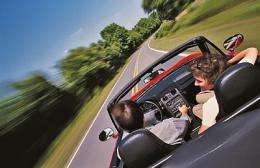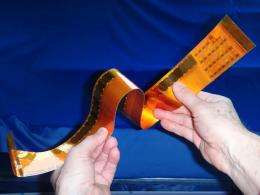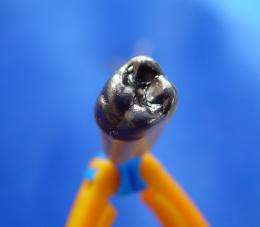Space foil helping to build safer cars

A special foil sensor developed to measure the pressure on a spaceplane’s wings during reentry into Earth’s atmosphere is now helping to build safer cars.
This ‘space’ foil has been transformed into a new super-thin and accurate sensor used by VW to measure every deformation suffered by cars during crash tests.
Space research leads to new technology
It all started in the early 1990s, when German engineer Paul Mirow was working on Europe’s Hermes spaceplane at Technical University Berlin. Hermes was planned as a reusable manned vehicle launched on Ariane 5.
To map the pressure distribution on the wings as Hermes returned through the atmosphere, a new sensor was needed because regular instruments were too bulky and added unrealistic drag. So Paul’s team turned to a special ‘piezoelectric’ foil to do the job.
Piezoelectric materials have a special property that converts physical effects like vibration and pressure into minute electric pulses. “It takes movement, forces or vibration, and turns it into an electrical signal,” Paul notes.
Super-thin sensor
In foil form, piezoelectric materials can serve as extremely lightweight sensors, able to cover an entire surface without distorting the results by adding drag.

“The piezoelectric foil is very thin, about 30 microns – a third of the thickness of a human hair,” explains Paul.
While other types of sensors create obstacles, with these piezoelectric foils, “You can just glue it to the surface, without creating any disturbances in the structure.”
The tests of Hermes’ wing in a hypersonic wind tunnel went well, and in 1995 Paul and his partners decided to adapt their piezoelectric foil for terrestrial applications.
One was even created for a dental company: “We painted a tooth with piezoelectric paint so they could measure the forces created by the toothbrush on the molar.”
Making cars safer
One of the most exciting applications was developed for VW to use in their crash tests.
At the yearly Hannover Fair, the German car company saw Paul’s products at the stand organised by ESA’s Technology Transfer Programme Office and its German partner, technology broker MST Aerospace.
VW hoped that the space sensors would solve a problem encountered in crash tests: sensors on cars are often destroyed at impact, making it difficult to collect highly accurate data throughout the crash process.

Contained in a highly flexible polymer film, the piezoelectric sensor is simply applied to the car’s surfaces. It moves with the metal as the car crashes, rather than being destroyed by the impact.
“The VW people asked, ‘is it possible to use this in crash tests?’” recalls Paul. “We said, ‘let’s try.’”
“We wanted to know at which moment which parts of the car are deformed,” explained Jens Weinrich, an engineer at VW.
“In a crash situation, it’s always a problem that you never know exactly what will happen.”
Paul’s firm developed a sensor in which each strip of foil contains 50 piezoelectric sensors, each about a square centimetre.
This makes it possible to measure exactly what is happening, and when, in exactly which places on the car. How fast is the metal bending? Is it bending 20º in one direction, or 60º in the other? And where precisely did it bend?
At the end of each strip, an equally thin, flexible printed circuit board with a 50-channel amplifier records the electrical impulses created by the mechanical deformations.
“We wanted not just qualitative, but also quantitative results,” said Mr Weinrich. “We wanted to know where it folded, and how much it folded.”
Following the development of the piezoelectric foil sensors, VW has now used them in a number of crash tests. The latest wrapped up last year after two years of intensive testing, helping VW to improve car safety.
Provided by European Space Agency




















